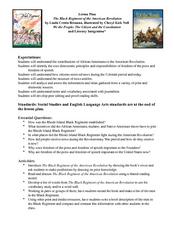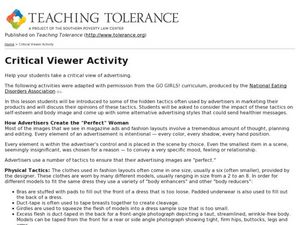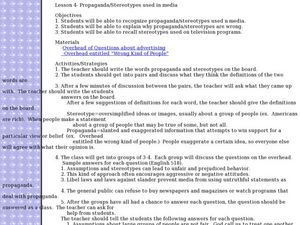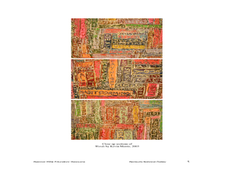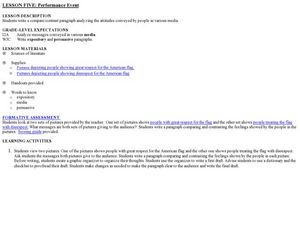National First Ladies' Library
Michigan vs. Ohio State: A Serious Rivalry!
Middle schoolers discuss and research the pros and cons of school rivalries. In particular, they study the Michigan-Ohio State rivalry. Through their research, they think about how media accounts of college football games can be shaped...
Social Media Toolbox
Twitter Time
Tweet all about it! Junior journalists explore the Twittersphere to determine its effectiveness as a news broadcasting tool in the 12th installment of the 16-part Social Media Toolbox. Participants follow and record their observations of...
Social Media Toolbox
Verification
When you're putting together a great story, you've got to consider the source! Scholars discover the dangers of errors in reporting during the 14th activity in a 16-part Social Media Toolbox series. Groups collaborate to create a source...
Curated OER
We the People: The Citizen and the Constitution: The American Revolution
The contributions of African-Americans to the American Revolution are the focus of this Social Studies and language arts lesson. After reading and discussing Linda Crotta Brennan’s The Black Regiment of the American Revolution, class...
iCivics
Lesson 3: Bias
How do journalists balance bias and ethical reporting? The final lesson in a series of five from iCivics examines the different types of bias and how they affect the news we read. Young reporters take to the Internet to find examples of...
Curated OER
Health: Media and Body Image
Fifth graders examine the influence of advertisements on body image and purchasing. They discuss the psychology behind the ads and working in groups cut out words in magazine advertisements that could entice them to buy the product. ...
Curated OER
Lesson Plan: The Black Press
High schoolers examine the history of the black press. In this media awareness lesson plan, students watch videos and conduct research regarding the history of the black press in America. High schoolers explore media careers as they read...
Curated OER
Media Stereotypes: How Differences Divide
Students differentiate between generalizations and stereotypes and compare and contrast gender representation. Finally, they critically analyze media for gender stereotypes. They look at magazines and create collages to focus in on the...
Curated OER
Finding Content/Media
Sixth graders use the web to find and download photos, images, and clip art to create a large library of images in a short time. They survey audio and video files and other media by using various search engines. Remember to follow...
Curated OER
The Media and Social Justice in the United States
Students investigate why the hip hop is sometimes called the CNN of black youth. They explore the political themes in American hip hop. Students examine the connection between art, media and social justice in hip hop.
Curated OER
Critical Viewer Activity
Young scholars practice media awareness. In this media awareness instructional activity, students analyze print and electronic media messages. Young scholars discover how advertisers use re-imaging to manipulate photographs and discuss...
Curated OER
Mixed-Media Self-Portrait with Symbols
Students watch segments of a video to explore portraits. They create a self portrait using mixed-media.
Curated OER
You Are There: Television News Reports on Apartheid
Students, in groups, research apartheid and its effects on South Africa. They present their information to the class.
Curated OER
Propaganda/Stereotypes Used in the Media
Students write a character sketch on a television character who they feel is a stereotype. In this propaganda/stereotype lesson, students discuss the definition of the terms and ways that the media uses both. Students relate...
Curated OER
Mixed Media Painting
Students create mixed media still life paintings in this "Happy Accident" art lesson introducing the concepts of using pen and ink, watercolors, and pastels. The lesson can be adapted for various grade levels and abilities ranging from...
Curated OER
Ad Awareness from Admongo.gov
Young scholars explore mass media by completing worksheets in class. In this consumerism lesson plan, students discuss the meaning behind advertisements and how they are used in television, the Internet and print. Young scholars analyze...
Curated OER
Sex on TV: Teens and Parents Talk
Students observe human psychology by completing a media analysis worksheet. In this parent and teen communication lesson, students identify the main programs on television today and how sex is used to sell the program as well as...
Curated OER
"Love & Diane" Lesson Plan: Expectations About Parenting
Students watch video clips of "Love & Diane," then discuss media messages and student expectations.
Curated OER
PICTURE READING - PARAGRAPH WRITING
Young scholars investigate the elements found in a media image. The image is used to compose a descriptive paragraph. They exchange papers to discuss the writing and make changes using constructive criticism. Students also make...
Curated OER
Words by Kevin Morris
Students analyze and discuss contemporary artwork of Kevin Morris, and create their own mind maps and poetry using Words by Morris as inspiration. Students then scan newspaper, write at least ten words that jump out at them, and discuss...
Curated OER
Stop the Bus: Confronting Our Assumptions About Muslims in America
Students explore Virginia Interfaith Center's A More Perfect Union "Misunderstanding" Ad Campaign, view two episodes of PBS America at a Crossroads series, examine historical context of colonialism and geo-political tensions in Middle...
Curated OER
Sweet-Talkers
Students investigate what is being sold to them. For this media awareness lesson, students visit selected websites to take a closer look at advertising marketed at them. Students discuss the implications of marketing geared toward children.
Curated OER
Creating the Goods
Learners market goods or services to one another. In this media awareness lesson, students use propaganda techniques to create commercials for goods or services of their choice.
Curated OER
Performance Event
Students examine the media by writing a compare/contrast paragraph. In this mass communications lesson, students identify and discuss the main sources of information for Americans in today's age. Students analyze pictures of people...





